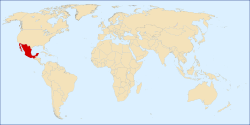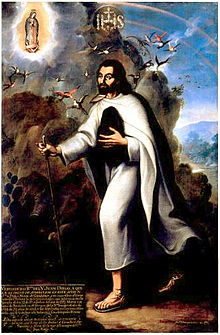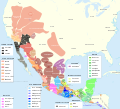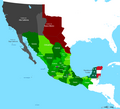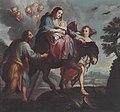Portal:Mexico
|
The Temple of Warriors at Chichen Itza, Mexico
¡Bienvenido! Welcome to the Mexico portal
Mexico, officially the United Mexican States, is a country in the southern portion of North America. It covers 1,972,550 km2 (761,610 sq mi), making it the world's 13th-largest country by area; with a population of almost 130 million, it is the 10th-most-populous country and the most populous Spanish-speaking country. Mexico is organized as a federal constitutional republic comprising 31 states and Mexico City, its capital. It shares land borders with the United States to the north, with Guatemala and Belize to the southeast; as well as maritime borders with the Pacific Ocean to the west, the Caribbean Sea to the southeast, and the Gulf of Mexico to the east.
This is a Featured article, which represents some of the best content on English Wikipedia.
 The Olmec colossal heads are stone representations of human heads sculpted from large basalt boulders. They range in height from 1.17 to 3.4 metres (3.8 to 11.2 ft). The heads date from at least 900 BC and are a distinctive feature of the Olmec civilization of ancient Mesoamerica. All portray mature individuals with fleshy cheeks, flat noses, and slightly-crossed eyes; their physical characteristics correspond to a type that is still common among the inhabitants of Tabasco and Veracruz. The backs of the monuments often are flat. The boulders were brought from the Sierra de Los Tuxtlas mountains of Veracruz. Given that the extremely large slabs of stone used in their production were transported over large distances (over 150 kilometres (93 mi)), requiring a great deal of human effort and resources, it is thought that the monuments represent portraits of powerful individual Olmec rulers. Each of the known examples has a distinctive headdress. The heads were variously arranged in lines or groups at major Olmec centres, but the method and logistics used to transport the stone to these sites remain unclear. They all display distinctive headgear and one theory is that these were worn as protective helmets, maybe worn for war or to take part in a ceremonial Mesoamerican ballgame. The discovery of the first colossal head at Tres Zapotes in 1862 by José María Melgar y Serrano was not well documented nor reported outside of Mexico. The excavation of the same colossal head by Matthew Stirling in 1938 spurred the first archaeological investigations of Olmec culture. Seventeen confirmed examples are known from four sites within the Olmec heartland on the Gulf Coast of Mexico. Most colossal heads were sculpted from spherical boulders but two from San Lorenzo Tenochtitlán were re-carved from massive stone thrones. An additional monument, at Takalik Abaj in Guatemala, is a throne that may have been carved from a colossal head. This is the only known example from outside the Olmec heartland. (Full article...)Selected article -Mexico City (Spanish: Ciudad de México, locally [sjuˈða(ð) ðe ˈmexiko] ⓘ; abbr.: CDMX; Central Nahuatl: Mexihco Hueyaltepetl, Nahuatl pronunciation: [meːˈʃiʔko wejaːlˈtepeːt͡ɬ]; Otomi: 'Monda) is the capital and largest city of Mexico, and the most populous city in North America. Mexico City is one of the most important cultural and financial centers in the world. It is located in the Valley of Mexico within the high Mexican central plateau, at an altitude of 2,240 meters (7,350 ft). The city has 16 boroughs or demarcaciones territoriales, which are in turn divided into neighborhoods or colonias. The 2020 population for the city proper was 9,209,944, with a land area of 1,495 square kilometers (577 sq mi). According to the most recent definition agreed upon by the federal and state governments, the population of Greater Mexico City is 21,804,515, which makes it the sixth-largest metropolitan area in the world, the second-largest urban agglomeration in the Western Hemisphere (behind São Paulo, Brazil), and the largest Spanish-speaking city (city proper) in the world. Greater Mexico City has a GDP of $411 billion in 2011, which makes it one of the most productive urban areas in the world. The city was responsible for generating 15.8% of Mexico's GDP, and the metropolitan area accounted for about 22% of the country's GDP. If it were an independent country in 2013, Mexico City would be the fifth-largest economy in Latin America. (Full article...)Selected pictureThis is a Good article, an article that meets a core set of high editorial standards.
 Plaza Sésamo (English: Sesame Plaza) is the first international co-production of the educational children's television series Sesame Street. Its first season premiered in Mexico in 1972, and the last season ended in 2018 during the holiday season and the 50th anniversary of Sesame Street, but the show returned in 2020. It has also aired throughout Latin America, to a potential audience of 25 million children in 34 countries. Unlike some of the earliest co-productions, which consisted of dubbed versions of Sesame Street sketches with local language voice-overs, Plaza Sésamo along with Vila Sésamo were actual co-productions. Half of the show was adapted from the American show, and half was original material, created in Mexico by Mexican writers, performers, and producers. The first season consisted of 130 half-hour episodes. The Plaza Sésamo development process was similar to that of the American show. Its goals were developed by local experts in television, child development, and early education during curriculum seminars in Caracas, Venezuela. Sésamo's goals emphasized problem solving and reasoning, and also included perception, symbolic representation, human diversity, and the child's environment. Other goals included community cooperation, family life, nutrition, health, safety, self-esteem, and expressing emotions. Early reading skills were taught through the whole language method. The show's budget for the first and second seasons was approximately US$1.6 million. The show's set consisted of a typical neighborhood square (or plaza) found throughout the region. New Muppets and human characters were created. In all, four seasons of Sésamo were filmed. The first season resulted in some of the highest ratings in Mexico. The fourth season, filmed in 1995, was broadcast in the U.S., making it the first foreign-language co-production shown in the U.S. Studies conducted after the first season of Sésamo showed that it had a demonstrable impact on the educational achievement levels of its young audience. Highly significant difference were found in tests about general knowledge, letters, and numbers after children were exposed to the show. Significant gains were made in several cognitive and perceptual areas by regular viewers, even in subjects that were not taught by the show. Characters from the show participated in campaigns promoting health and nutrition; in 2009, Sesame Workshop, the organization responsible for the show, was awarded the "Champion of Health" award by the Pan American Health Organization (PAHO) for its efforts. (Full article...)Selected biography -Juan Diego Cuauhtlatoatzin, also known simply as Juan Diego (Spanish pronunciation: [ˌxwanˈdjeɣo]; 1474–1548), was a Chichimec peasant and Marian visionary. He is said to have been granted apparitions of Our Lady of Guadalupe on four occasions in December 1531: three at the hill of Tepeyac and a fourth before don Juan de Zumárraga, then bishop of Mexico. The Basilica of Our Lady of Guadalupe, located at the foot of Tepeyac, houses the cloak (tilmahtli) that is traditionally said to be Juan Diego's, and upon which the image of the Virgin is said to have been miraculously impressed as proof of the authenticity of the apparitions. Juan Diego's visions and the imparting of the miraculous image, as recounted in oral and written colonial sources such as the Huei tlamahuiçoltica , are together known as the Guadalupe event (Spanish: el acontecimiento Guadalupano), and are the basis of the veneration of Our Lady of Guadalupe. This veneration is ubiquitous in Mexico, prevalent throughout the Spanish-speaking Americas, and increasingly widespread beyond. As a result, the Basilica of Our Lady of Guadalupe is now one of the world's major Christian pilgrimage destinations, receiving 22 million visitors in 2010. (Full article...)
In the news
Selected fare or cuisine -
Guacamole (Spanish: [ɡwakaˈmole] ⓘ; informally shortened to guac in the United States since the 1980s) is an avocado-based dip, spread, or salad first developed in Mexico. In addition to its use in modern Mexican cuisine, it has become part of international cuisine as a dip, condiment and salad ingredient. (Full article...)
General imagesThe following are images from various Mexico-related articles on Wikipedia.
CategoriesTopicsRelated portalsWikiProjectYou are invited to participate in WikiProject Mexico, a WikiProject dedicated to developing and improving articles about Mexico. Associated WikimediaMore portals | ||||||||||




